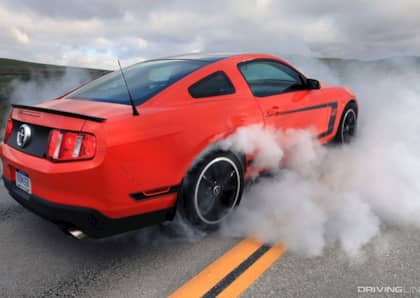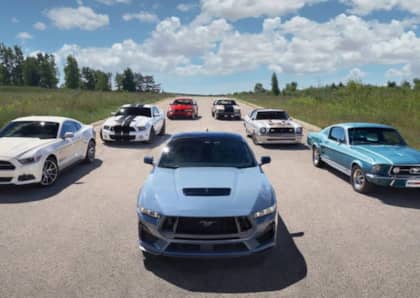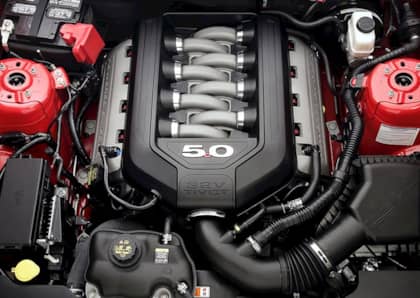The 5 Best Ford V8 Engines of All-Time
Ford has brought dozens of V8 engine designs to the table in its long history, but in the high performance world there are a handful that stand out as significant achievements both in terms of engineering and their importance to the brand.
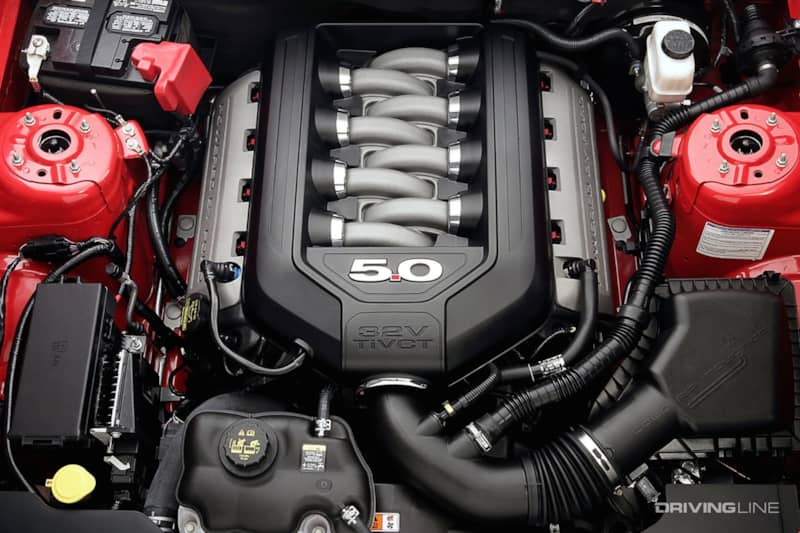
Which Ford V8 engines are the best? We took a deep drive into the company's past to determine which motors had the biggest impact on Ford's reputation for performance, which ones made the difference on a race track, and which engines made their mark among American muscle car fans across the decades.
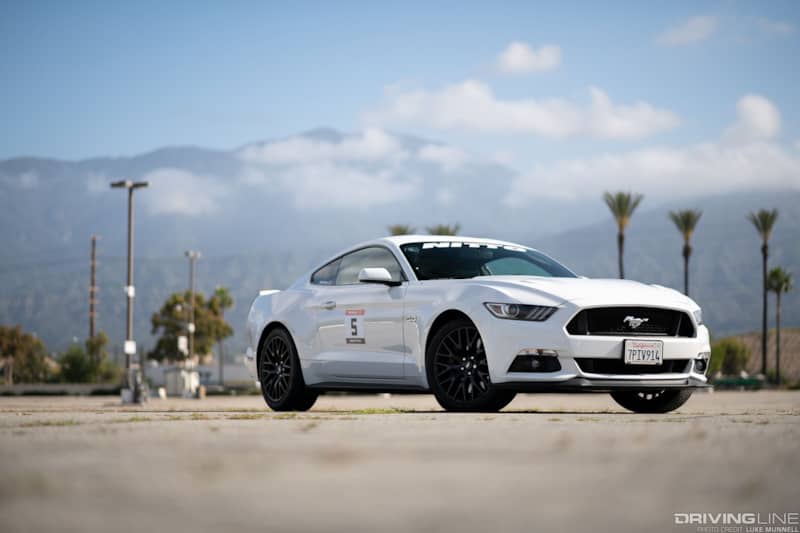
Ford Flathead
The Ford flathead wasn't the first V8 engine to come out of Detroit (that would be Cadillac's 1915 effort), but when it arrived for 1932 it was certainly the most affordable, sparking off a power revolution under the hood of American cars that continues to this day. Unlike other V-layout, eight-cylinder engines of its time, the flathead was designed specifically to be mass produced, which gave it a huge edge in cost over the boutique V8s available from other automakers.

Henry Ford's fingerprints were all over the flathead's design, which was simplified for improved reliability and ease of assembly. Featuring a one-piece cast block (as opposed to the bolted-together units found on rival V8s), the engine evolved over the course of several years to address issues such as piston wear and oil consumption. It also installed positive crankcase ventilation and improved water cooling.

Power from the engine grew from its initial 65 hp up to 85 hp within just a few years, and by the end of World War II numerous versions of the flathead were available for applications ranging from passenger cars to commercial trucks. The flathead became the preferred drivetrain for servicemen returning from overseas who were eager to explore the burgeoning hot rod culture coming out of California at the time, and it wasn't long before roadsters and land speed racers alike were stuffing the design into their homebuilt projects.
It's no exaggeration to say that Ford's flathead was the foundation of hot rodding, and the world of expertise and aftermarket performance parts that sprung up around it set the tone for the next several generations of enthusiasts.
Ford 427
The Ford 427 cubic inch big block V8 was intended to dominate motorsports in the early 1960s, and in many respects it was mission accomplished for the Blue Oval. A bored out version of the 390 cubic inch FE V8, the 427 was strengthened with a forged crankshaft, featured solid lifters, and offered a high-nickel iron alloy block. The engine also included a side-oiling system that was intended to fight against the g-force pull of circle track racing and keep the 427 lubed at all times.

It was possible to order a 427 in a street car—full-size models like the Galaxie, mid-sizers like the Fairlane—and benefit from as much as 425 hp and 480 lb-ft of torque, but the real prize were the drag and circle track racing engines Ford produced. Featuring a range of high-rise and mid-rise heads, and even an ultra-advanced single overhead cam version of the motor (dubbed the 'Cammer'), Ford motorsports 427s were good for between 500 hp and 2,500 hp and were even targeted by rule-changing NASCAR officials worried about upsetting the balance of its on-track spectacle.

Rare on the street due to its significant cost (to both Ford in production and customers on the window sticker), perhaps the engine's greatest claim to fame was its dominant performance at Le Mans, where it motivated the iconic GT40 to victory in 1966, as well as its presence between the front fenders of the big block Shelby Cobra roadster.
Boss 302
Despite sharing its displacement with the more common Ford V8s of the time, the Boss 302 that married the Cleveland's heads to a completely different block outfitted with 4-bolt mains and the same high-nickel iron found in the 427. Purpose built to go Trans Am racing, the Boss made use of a tall deck, high performance connecting rods, a cross-drilled, forged crankshaft, sodium-filled exhaust valves, forged pop-up pistons, and an aggressive camshaft to feed the large ports of its heads.

Ford installed the unique 302 in both the Mercury Cougar and the Ford Mustang, taking them racing in 1969 and 1970 in the Trans Am series. With 290 horsepower and 290 lb-ft of torque on tap the engine wasn't exactly a world killer in the muscle car wars on the street, but on a race track the unit could do 8,000 rpm all day long, providing a very different high performance experience and earning Ford the manufacturer's championship in 1970 with Parnelli Jones behind the wheel.
5.0 H.O.
The middle child of the three 5.0L V8 engines on this list, in the late 1970s Ford undertook a program of modernization aimed squarely at turning the Windsor V8 back into a viable performance option. The first fruits arrived in 1982 with the 5.0 H.O. or 'high output,' a term that at first referred to a modest 157 hp but eventually rose to 225 hp by the beginning of the 1990s.

It was the engine that put Dearborn back on the map when it came to street performance, and like the flathead it eventually benefited from one of the largest aftermarkets in V8 history.

Although initially carbureted, it was the introduction of electronic fuel injection as standard equipment for the 1986 model year that transformed the 5.0 into a legend. Found under the hood of the Fox-body Mustang (as well as numerous other Ford, Lincoln, and Mercury vehicles), the H.O. had by that time gained hydraulic roller lifters and better-breathing heads, putting 285 lb-ft of torque on the menu. The engine would continue to be refined throughout the decade (gaining a mass airflow system to replace its speed density setup, along with a set of hypereutectic pistons), lasting until the end of the '90s when the Mustang, and then the Ford Explorer switched to Ford's modular V8.
5.0 Coyote
After nearly 15 years, Ford returned to the 5.0 well—only this time, the engine was derived from the brand's overhead camshaft modular family rather than its original pushrod namesake. Designed specifically for the Mustang (and later adapted to platforms like the F-150), the engine incorporated more high tech features than any previous Ford V8.

The Coyote 5.0 was the first Ford eight-cylinder engine to feature twin variable camshaft timing on both the exhaust and the intake, and the aluminum block was webbed rather than reinforced in order to give it additional strength. It also featured entirely new DOHC heads that shared little with the three-valve single overhead camshaft design of the older modular engines that had populated the Mustang's engine bay.

Initially, the engine was good for 420 hp and 390 lb-ft of torque, eventually climbing to 435 hp in the Mustang thanks to improved cylinder heads and camshafts that debuted in 2015, and then 460 hp after the introduction of direct fuel injection in 2018. The Ti-VCT system makes the Coyote easy to tune for boost, and early versions of this engine enjoy considerable attention from hot rodders and performance parts manufacturers.

The 5.0 Coyote also got its own special edition Boss 302 variant, a 444 hp designer known internally as the 'Roadrunner' that featured unique cams, ported heads, and forged connecting roads in order to provide a similar high RPM powerband as compared to its golden era namesake. The Coyote also served as the basis for the Boss 302's replacement, the 5.2-liter, flat-plane crankshaft V8 installed under the hood of the Shelby GT350 that boosted its redline from 7,500 rpm in the Boss to 8,240 rpm. The 'Voodoo' engine offered up a whopping 526 hp and 429 lb-ft of torque, and set the stage for the supercharged variant dubbed the 'Predator,' which churns out 760 hp in the Mustang Shelby GT500.
More From Driving Line
- Here's How Ford's 302 Small Block V8 Evolved Into The 5.0 And Defined High Performance For 30 Years
- A History Of The Ford 427 Big Block V8 That Changed Blue Oval Motorsports Forever
- The Ford 351 V8 Came In Cleveland, Windsor, and Michigan (Modified) Flavors
- A History of the Ford 429ci V8, The Blue Oval's Final Big Block Muscle Car Blast
- A History Of The Ford 460, The Blue Oval's Longest-Lasting Truck Big Block V8
- A History Of The Ford 460, The Blue Oval's Longest-Lasting Truck Big Block V8




